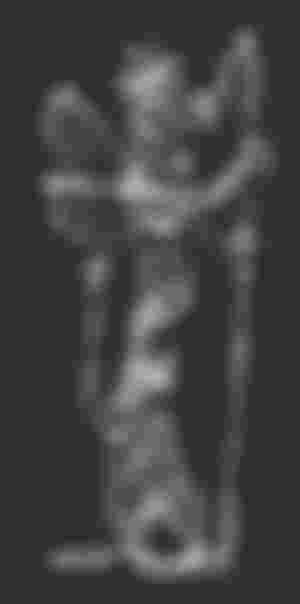Sumerian Religion
Greetings to all my readers.
Sumerian faith turned into the faith practiced through the people of Sumer, the primary literate civilization of historic Mesopotamia. The Sumerians appeared their divinities as responsible for all topics concerning the natural and social orders.

The Sumerians believed that the universe had come into being thru a series of cosmic births. First, Nammu, the primeval waters, gave birth to Ki (the earth) and An (the sky), who mated collectively and produced a son named Enlil. Enlil separated heaven from earth and claimed the earth as his domain. Humans have been believed to have been created via Enki, the son of Nammu and An. Heaven turned into reserved exclusively for deities and, upon their deaths, all mortals' spirits, irrespective of their conduct at the same time as alive, were believed to visit Kur, a chilly, darkish cavern deep beneath the earth, which changed into ruled by the goddess Ereshkigal and wherein the handiest meals available became dry dust. In later times, Ereshkigal became believed to rule alongside her husband Nergal, the god of death.
The predominant deities within the Sumerian pantheon included An, the god of the heavens, Enlil, the god of wind and typhoon, Enki, the god of water and human way of life, Ninhursag, the goddess of fertility and the earth, Utu, the god of the sun and justice, and his father Nanna, the god of the moon. During the Akkadian Empire, Inanna, the goddess of intercourse, beauty, and war, changed into widely commemorated across Sumer and appeared in lots of myths, consisting of the famous story of her descent into the Underworld.
Sumerian faith heavily stimulated the religious beliefs of later Mesopotamian peoples; elements of it are retained within the mythologies and religions of the Hurrians, Akkadians, Babylonians, Assyrians, and other Middle Eastern lifestyle groups. Scholars of comparative mythology have observed parallels among the tales of the historic Sumerians and those recorded later within the early components of the Hebrew Bible.

Sumerian myths were passed down through the oral tradition until the invention of writing (the earliest myth discovered so far, the Epic of Gilgamesh, is Sumerian and is written on a series of fractured clay tablets). Early Sumerian cuneiform was used primarily as a record-keeping tool; it was not until the late Early Dynastic period that religious writings first became prevalent as temple praise hymns and as a form of "incantation" called the nam-sub. These tablets were also made of stone clay or stone, and they used a small pick to make the symbols.
In the Sumerian metropolis-states, temple complexes at the start were small, extended one room structures. In the early dynastic period, temples evolved raised terraces and more than one rooms. Toward the give up of the Sumerian civilization, ziggurats have become the preferred temple shape for Mesopotamian non secular facilities. Temples served as cultural, spiritual, and political headquarters till approximately 2500 BC, with the upward thrust of army kings called Lu-gals after which period the political and army leadership turned into regularly housed in separate "palace" complexes.
Until the advent of the Lugal, Sumerian town states have been under a really theocratic authorities managed by means of various En or Ensí, who served because the high clergymen of the cults of the town gods. (Their girl equivalents were called Nin.) Priests have been liable for persevering with the cultural and religious traditions of their metropolis kingdom, and had been regarded as mediators between people and the cosmic and terrestrial forces. The priesthood resided fulltime in temple complexes, and administered topics of kingdom which includes the large irrigation approaches essential for the civilization's survival.

The majority of Sumerian deities belonged to a class called the Anunna “offspring of An”, while seven deities, together with Enlil and Inanna, belonged to a collection of “underworld judges" called the Anunnaki offspring of An” Ki). During the Third Dynasty of Ur, the Sumerian pantheon become said to consist of sixty instances sixty (3600) deities.
Enlil became the god of air, wind, and storm. He was additionally the chief god of the Sumerian pantheon and the customer deity of the city of Nippur. His number one consort was Ninlil, the goddess of the south wind, who became one of the matron deities of Nippur and became believed to reside within the same temple as Enlil. Ninurta become the son of Enlil and Ninlil. He become worshipped because the god of battle, agriculture, and one of the Sumerian wind gods. He turned into the customer deity of Girsu and one of the customer deities of Lagash.
Enki became god of freshwater, male fertility, and expertise. His maximum crucial cult center become the E-abzu temple within the town of Eridu. He changed into the consumer and author of humanity and the sponsor of human lifestyle. His number one consort become Ninhursag, the Sumerian goddess of the earth. Ninhursag turned into worshipped inside the towns of Kesh and Adab.
Inanna changed into the Sumerian goddess of love, sexuality, prostitution, and struggle. She become the divine personification of the planet Venus, the morning and night big name. Her predominant cult center turned into the Eanna temple in Uruk, which have been originally committed to An. Deified kings may additionally have re-enacted the wedding of Inanna and Dumuzid with priestesses. Accounts of her parentage range; in most myths, she is typically supplied because the daughter of Nanna and Ningal, but, in different stories, she is the daughter of Enki or An along side an unknown mother. The Sumerians had more myths about her than some other deity. Many of the myths involving her revolve around her attempts to usurp manage of the opposite deities' domains.

Utu was god of the sun, whose number one center of worship turned into the E-babbar temple in Sippar. Utu became mainly appeared as a dispenser of justice; he turned into believed to protect the righteous and punish the wicked. Nanna become god of the moon and of awareness. He become the father of Utu and one of the consumer deities of Ur. He may additionally have also been the daddy of Inanna and Ereshkigal. Ningal turned into the spouse of Nanna, as well as the mother of Utu, Inanna, and Ereshkigal.
Ereshkigal turned into the goddess of the Sumerian Underworld, which become referred to as Kur. She become Inanna's older sister. In later fantasy, her husband became the god Nergal. The gatekeeper of the underworld turned into the god Neti.
Nammu became a goddess representing the primeval waters Engur, who gave birth to An and Ki and the primary deities; even as she is hardly ever attested as an object of cult, she possibly played a primary role in the early cosmogony of Eridu, and in later periods continued to seem in texts related to exorcisms. An was the historical Sumerian god of the heavens. He turned into the ancestor of all of the different major deities and the unique purchaser deity of Uruk.
Most essential gods had a so referred to as sukkal, a minor deity serving as their vizier, messenger or doorkeeper.

Akkadians
Assyrian stone comfort from the temple of Ninurta at Kalhu, showing the god together with his thunderbolts pursuing Anzu, who has stolen the Tablet of Destinies from Enlil's sanctuary (Austen Henry Layard Monuments of Nineveh, 2nd Series, 1853)
The Sumerians had an ongoing linguistic and cultural trade with the Semitic Akkadian peoples in northern Mesopotamia for generations previous to the usurpation of their territories with the aid of Sargon of Akkad in 2340 BC. Sumerian mythology and spiritual practices had been rapidly incorporated into Akkadian subculture, possibly mixing with the original Akkadian notion systems which have been frequently lost to history. Sumerian deities evolved Akkadian opposite numbers. Some remained in reality the equal until later Babylonian and Assyrian rule. The Sumerian god An, as an instance, advanced the Akkadian counterpart Anu; the Sumerian god Enki have become Ea. The gods Ninurta and Enlil saved their authentic Sumerian names.
Babylonians
The Amorite Babylonians received dominance over southern Mesopotamia by way of the mid-17th century BC. During the Old Babylonian Period, the Sumerian and Akkadian languages were retained for religious purposes; most of the people of Sumerian mythological literature regarded to historians nowadays comes from the Old Babylonian Period, both inside the form of transcribed Sumerian texts (maximum drastically the Babylonian version of the Epic of Gilgamesh) or inside the shape of Sumerian and Akkadian affects within Babylonian mythological literature (maximum substantially the Enûma Elis). The Sumerian-Akkadian pantheon became altered, maximum notably with the advent of a new very best deity, Marduk. The Sumerian goddess Inanna additionally advanced the counterpart Ishtar during the Old Babylonian Period.
Hurrians
The Hurrians followed the Akkadian god Anu into their pantheon someday no later than 1200 BC. Other Sumerian and Akkadian deities tailored into the Hurrian pantheon include Ayas, the Hurrian counterpart to Ea; Shaushka, the Hurrian counterpart to Ishtar; and the goddess Ninlil, whose mythos have been notably increased by way of the Babylonians.

Parallels
Some memories recorded in the older elements of the Hebrew Bible undergo strong similarities to the testimonies in Sumerian mythology. For example, the biblical account of Noah and the Great Flood bears a putting resemblance to the Sumerian deluge fantasy, recorded in a Sumerian pill discovered at Nippur. The Judaic underworld Sheol could be very comparable in description with the Sumerian Kur, ruled by means of the goddess Ereshkigal, as well as the Babylonian underworld Irkalla. Sumerian pupil Samuel Noah Kramer has additionally cited similarities among many Sumerian and Akkadian "proverbs" and the later Hebrew proverbs, many of which are featured within the Book of Proverbs.
I hope you like the blog what you reading and see you in the next one .





